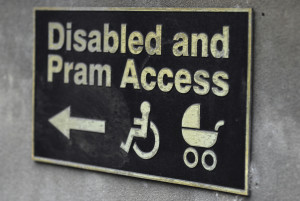AARP Hearing Center
How the Americans With Disabilities Act Benefits All of Us
By Katherine Bouton, August 26, 2015 05:08 PM

No disability? Guess what. You benefit from the Americans With Disabilities Act every single day.
Let’s start with wheelchair access. Parents pushing strollers, travelers with rolling suitcases, bicyclists (who should be walking the bike, not riding), workers with hand trucks, shoppers with carts full of groceries — none of these are the intended beneficiaries of wheelchair ramps, but wheelchair ramps make life a lot easier.
Doorways in new construction and in public places must accommodate wheelchairs, and in the process they accommodate parents with double strollers, people with bulky packages, the obese, the elderly with walkers or scooters, couples walking arm in arm.
Get the latest tips on staying healthy — AARP Health Newsletter »
Or consider my disability, hearing loss. If you’ve ridden on the Boston T or the Washington Metro or the New York City subway recently— or likely on any other form of public transportation—you’ve benefited from the ADA. Signage—often LED displays which also add light—provide up-to-date information that everyone can understand.
These signs tell you how to buy a ticket, which track to go to, when the train is coming, why the train is NOT coming, what the next stop is, and which stations you can transfer to at that stop. Ten years ago, you had to rely on garbled information from a public address amplifier when using these public transit systems. Not only did those with hearing loss not understand what was said, nobody else did either.
Accommodations for the blind have a more subtle benefit. Few of those who aren't blind gain from braille lettering on elevators and elsewhere, but they do benefit — even subconsciously — from the beeps that tell the blind what floor they’re on in those elevators. In the same way, a distracted pedestrian is reminded, often without being aware of it, by the beeping at a crosswalk about when it’s safe to cross.
Accessible sinks, ATMs, water fountains, ticket machines, telephone booths —these all help not only those in wheelchairs, but anyone who is short, including children.
Elevators in transit hubs allow people in wheelchairs access to elevated or below-ground tracks and amenities, but they are also useful for those with luggage or children or packages, or anyone just too worn out after a day at the office to climb the stairs.
Get discounts on hearing aids with your AARP Member Advantage »
The benefits are global as well: These improvements make the workforce more inclusive, lower unemployment and reduce disability payments. Accommodations allow families with handicapped members to go to amusement parks, sports events, and a host of other activities. Making schools accessible exposes children to those with disabilities, instilling a tolerance for difference at an early age.
The world is a better place in ways large and small, thanks to the ADA.
Photo: Libusca/iStock
Also of Interest
- Why did CDC disability report exclude hearing loss?
- BMI calculator: How healthy is your weight?
- Get Help: Find out if you're eligible for public benefits with Benefits QuickLINK
- Join AARP: Savings, Resources and News for Your Well-Being
See the AARP home page for deals, savings tips, trivia and more.































































